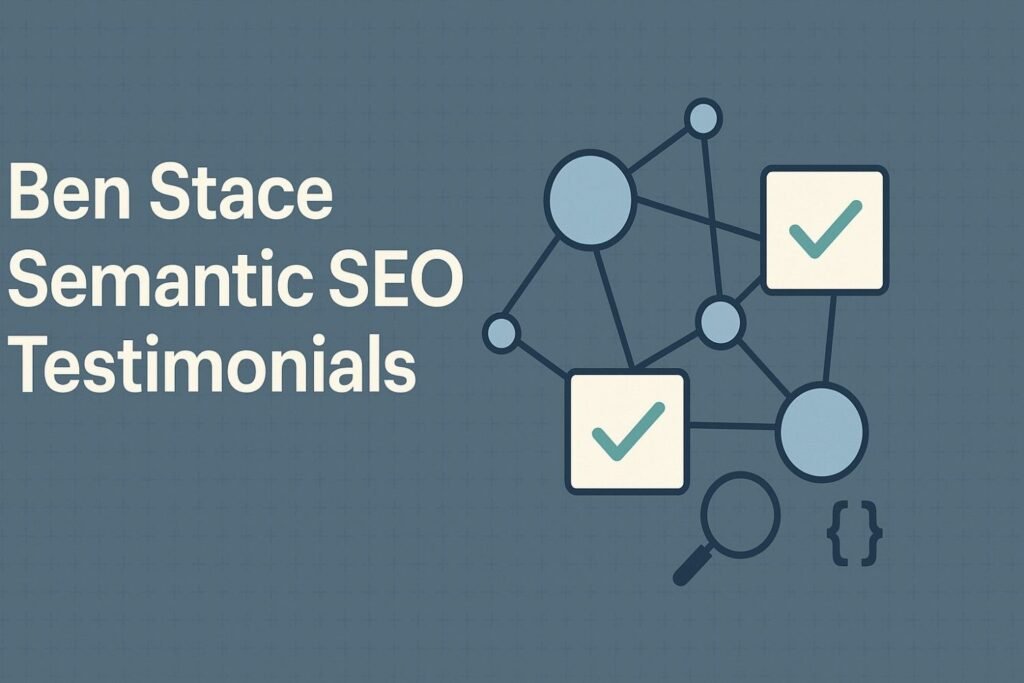Searching for Ben Stace semantic SEO testimonials? This guide shows where to find credible reviews, how to separate proof from praise, and a short workflow to verify results—before you spend a dollar.
Why This Page Exists
“Testimonials” pages often list glowing blurbs that don’t tell you who said what, when it happened, or how the results were achieved. If you’re researching Ben Stace and semantic SEO, you need verifiable sources and a repeatable way to sanity-check claims. Consider this your pragmatic buyer’s companion.
Where to Find Real Testimonials (Beyond Vendor Pages)
- Video platforms: search “Ben Stace testimonial”, “topical map results”, and filter by Upload date to spot recent, on-camera reviews.
- Conference talks & podcasts: look for clips where a client explains outcomes and the specific semantic SEO work involved.
- Client blogs & case studies: credible posts cite URLs, timelines, and KPIs (clicks, impressions, top-3 keywords, qualified leads).
- Social posts with data: GA4/Search Console graphs with dates, not cropped screenshots without axes.
- Independent directories: listings where reviewers use real names and companies you can cross-check.
Tip: prioritize testimonials that live on third-party domains controlled by the client or platform, not only on a vendor’s site.
Anatomy of a Credible Testimonial (SCORE Test)
| Letter | What to Expect | Why It Matters |
|---|---|---|
| S — Source | Full name, role, company; ideally LinkedIn or site link. | Avoids anonymous praise you can’t verify. |
| C — Change | Before/after description (“top-3 keywords from 12 → 38 in 90 days”). | Shows trajectory, not just a snapshot. |
| O — Objective metrics | Clicks, impressions, conversions, qualified leads; clearly labeled as organic. | Prevents mixing paid or seasonal surges with SEO wins. |
| R — Replicable method | Mentions entities, topic clusters, internal linking, refresh cadence, schema. | Lets you attempt the approach on a small section of your site. |
| E — External corroboration | Evidence hosted outside the vendor’s domain (video, slides, client blog). | Reduces bias and raises trust. |
The 10-Minute Test: Verify Any Testimonial Fast
- Identify the person. Confirm name, role, and company on LinkedIn/website.
- Check the date. Ensure the result is recent enough to reflect the current SERP.
- Locate the baseline. Ask for pre-engagement metrics (clicks, impressions, top-3 keywords).
- Compare the delta. Request after-engagement metrics over the same time window.
- Review the method. Look for entity/cluster planning, internal links, and schema changes.
- Validate outside sources. Seek a video, slide deck, or client post repeating the same numbers.
Good consultants expect these questions. If answers are evasive, treat that as signal.
60-Day Sandbox Plan: Prove Semantic SEO on Your Site
- Weeks 1–2 — Map the topic & entities. Choose one revenue-adjacent hub; define pillar + 6–10 supports; list PAA questions.
- Weeks 3–4 — Publish + structure. Draft/refresh pages; add FAQ/HowTo blocks; implement Article/FAQ JSON-LD; compress media; ship.
- Weeks 5–6 — Interlink & fix crawl. Add contextual links between nodes; remove orphan pages; ensure fast LCP and CLS stability.
- Weeks 7–8 — Iterate from data. Expand weak answers, improve intros to match intent, resubmit key URLs; track top-10 → top-3 movement and snippet/PAA wins.
Even modest gains here help you judge whether a Ben-style semantic approach fits your niche—no leap of faith required.
Common Red Flags (Proceed Carefully)
- Quotes with only first names or blurred headshots.
- Screenshots without axes, dates, or channel labels.
- Promises of guaranteed rankings or fixed timelines regardless of competition.
- Results that can’t be tied to shipped URLs and internal-link changes.
- No mention of entities, topic clustering, or schema when claiming “semantic SEO.”
FAQs
Are Ben Stace semantic SEO testimonials trustworthy?
Many buyers report positive experiences, but every claim should pass the SCORE test and the 10-minute verification workflow above.
What results are realistic from a semantic SEO project?
While no one can guarantee rankings, strong signals include richer PAA/snippet coverage, growth in top-3 queries, and better qualified traffic for mapped entities.
How do I compare multiple providers using testimonials?
Normalize by timeframe and difficulty. Ask each provider for the list of shipped URLs and an internal-link map so you can compare apples to apples.
Next Step
Use testimonials as a starting point—not a finish line. Validate sources, ask for before/after evidence, and trial the sandbox plan. If you want help tailoring the rubric to your site, book a quick consult and we’ll adapt the workflow to your industry.

